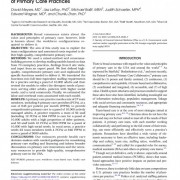You are looking at an archived version of our site. Please visit thepcc.org for a fresh, new experience!
Workforce
The primary care workforce is dwindling. Healthcare professionals in the United States are avoiding primary care for a multitude of reasons. Whether it be the excessive administrative burden, high rates of burnout, low reimbursement rates, or medical education emphasizing specialization, people are rapidly abandoning primary care. The lack of primary care clinicians creates large primary care deserts, especially in rural areas. Several state and federal programs attempt to offer incentives, to hopefully motivate people to pursue careers in primary care. However at this point, the discrepancy remains.
Resources
Practice Facilitation Training Modules | February 2022
More information and registration | September 2020

Get Hired in Healthcare: An Online Guide for Student Veterans | August 2019

Journal of the Association of American Medical Colleges | March 2016
This resource explores a pilot that aimed to improve chronic disease management through collaboration between medical students and faculty. It showed great potential that interdisciplinary care teams can help to improve patient engagement and retention.

Journal of General Internal Medicine | February 2015
As practices transform towards the PCMH model, it is important for clinicians to be trained in a more person- and family-centered manner of care. This ensures that patients are getting the right care at the right time, thus improving the patient experience while preventing unnecessary costs.
- 1 of 8
- next ›
Related Content
Pages
Pages
Associated Stakeholders:
Secondary menu
Copyright © 2024 Primary Care Collaborative

















